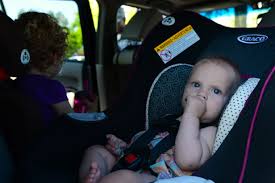 New changes to the Child Passenger Protection Act have gone into effect in Illinois, expanding child safety seat requirements based on age, height, and weight.
New changes to the Child Passenger Protection Act have gone into effect in Illinois, expanding child safety seat requirements based on age, height, and weight.
Illinois Child Passenger Protection Act
The Child Passenger Protection Act previously required that all children under the age of eight be secured properly in a child safety restraint system, including the use of booster seats, but only with the use of a lap/shoulder safety belt. If the backseat of the vehicle did not have lap/shoulder safety belts, a youth who weighed more than 40 pounds could be secured in the backseat with a lap belt only.
On January 1, 2019, however, new amendments to the Child Passenger Protection Act went into effect, with different child safety seat requirements for various age groups, along with exemptions based on height and weight.
Child Safety Seat Requirements Before Age Two
The amended Act requires children under two years of age to be secured in a rear-facing child restraint system. This requirement is waived if the child is 40 or more inches tall or weighs 40 or more pounds. Barring these exceptions, children must remain in a rear-facing child safety seat until age two.
Children in this age group who are riding rear-facing must do so in either a rear-facing-only car seat or a convertible car seat that has been installed rear-facing. Additionally, the Act lists the following installation guidelines:
- Do not install a rear-facing seat in front of an active airbag;
- Allow at least one inch below the top of the rear-facing seat for the child’s head;
- Follow the recline indicator when installing a rear-facing seat;
- Place the harness straps/slots at or below the shoulder level when rear-facing; and
- Make sure the harness snaps are snug and the harness clip is at armpit level.
From Ages Two Through Four
Children in this age group should remain in a rear-facing child safety seat until they exceed the upper weight or height limit, at which point they may transition to a forward-facing child safety seat. Additionally, parents or caretakers should do the following:
- Use the internal harness system until the until weight or height limit is reached or exceeded;
- Keep harness straps/slots at or above the shoulder level when forward-facing;
- Make sure the top of the child’s ears are not above the top of the forward-facing child safety seat; and
- Keep the harness clip at armpit level and the harness straps snug.
From Ages Four Through Eight
Children in this age range should remain in a front-facing child safety seat until they reach the upper weight or height limit allowed by the manufacturer, at which point they may transition to a belt-positioning booster seat. Additionally, the State of Illinois recommends the following guidelines:
- Booster seats must be used with a lap/shoulder belt, not just a lap belt;
- The shoulder belt should rest snugly across the shoulder and chest, not the face or neck;
- The lap belt should lie low across the upper thighs, never the stomach;
- If using a booster seat with a back, make sure the top of the child’s ears are not above the top of the booster seat’s back;
- If using a backless booster seat, position the vehicle’s head restraint properly; and
- Secure the booster seat with the seatbelt when it is not in use.
From Ages Eight Through Twelve
From ages eight through twelve, keep the child in a belt-positioning booster seat until he or she is tall enough to fit properly into an adult lap/shoulder belt. Once the child transitions to a lap/shoulder belt, observe the following safety guidelines:
- Make sure the lap belt lies low across the upper thighs instead of the stomach;
- Place the shoulder belt snugly across the shoulder and chest, not the face or neck;
- Keep the hips and back of the child against the back of the seat, with no slouching; and
- Make sure that the child’s knees bend easily over the front edge of the seat and with the child’s feet flat on the floor.
General Child Passenger Safety Guidelines
The Child Passenger Protection Act also presents some general safety guidelines:
- Keep child passengers in rear-facing safety seats for as long as possible;
- Place children in the backseat until at least age twelve;
- Caution against installing a used child safety seat, as it may not be safe unless all labels, parts, and instructions are present and you know the seat’s history;
- Never use a child safety seat that is over six years old or past the stamped expiration date;
- Do not attach non-regulated products such as toys, mirrors, window shades, and belt-tightening tools unless the child safety seat manufacturer allows them;
- Always be sure to register your child safety seat with its manufacturer so you can be informed of any recalls; and
- Tie down all objects in the vehicle or stow them in the trunk so that they do not become dangerous projectiles in the case of a car accident or sudden stop.
Serious Penalties for Endangering a Child
The purpose of the Child Passenger Protection Act and other child-protection legislation is to keep our children safe, something that any parent or caregiver should want. But this is not just helpful advice – it’s the law! Endangering the life or health of a child can bring serious legal consequences.
One of the forms of child endangerment that is specific to child passengers is leaving a child six years of age or under unattended in a motor vehicle for more than ten minutes – meaning either not accompanied by a person age 14 or older or out of sight of that person.
For these and other acts of child endangerment, the at-fault party could suffer a variety of possible penalties depending on the circumstances:
- For a first violation, a sentence of up to one year in jail and as much as $2,500.00 in fines;
- For a second violation, a sentence from two to five years in prison and a fine of upwards of $25,000.00; and
- For a violation that results in the death of the child, a prison sentence from two to ten years (in cases where the negligent party is sentenced to prison).
Given the seriousness of the stakes involved, we at GWC urge all motorists to take the steps needed to keep your children safe and sound on the road.
<< BACK TO BLOG POSTS